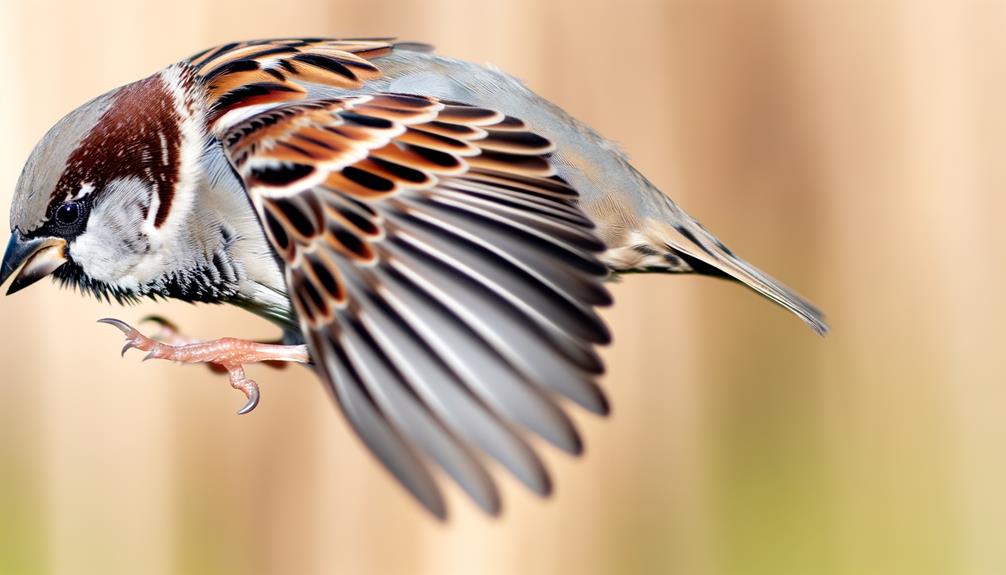Does the Sparrow Fly: Understanding Flight Step-by-Step
Sparrows soar through a synergy of their lightweight skeletal structure, specialized feather arrangement, and powerful flight muscles like the pectoralis and supracoracoideus. Their wingbeat frequency ranges from 8 to 12 Hz, facilitated by precise wrist and elbow joint movements.
Aerodynamically, sparrows balance lift, drag, and thrust by adjusting wing angles and beat frequency. Streamlined wing profiles and covert feathers reduce turbulence, enhancing maneuverability.
Muscular endurance, supported by mitochondria-rich fibers, guarantees sustained flight, while evolutionary adaptations like short, rounded wings aid rapid takeoff. Each of these factors contributes to their dynamic flight capabilities.
To uncover detailed mechanisms, observe further.

Key Takeaways
- Sparrows use lightweight skeletal structures and specialized feather arrangements for rapid and agile flight.
- Pectoralis and supracoracoideus muscles provide efficient force transmission and are crucial for wing movements.
- Wingbeat frequency of 8 to 12 Hz and joint articulation modulate wing dynamics for controlled flight.
- Streamlined wing profiles and covert feathers enhance maneuverability and reduce turbulence.
- High-density mitochondria and capillary networks in muscles support sustained aerobic activity for long flights.
Sparrow Wing Structure

The wing structure of a sparrow is crucial for its agile flight capabilities. It is characterized by a lightweight yet robust skeletal framework and specialized feather arrangement. The skeletal framework comprises the humerus, radius, and ulna bones, which offer the necessary support and flexibility.
The feathers play a significant role in optimizing aerodynamics and lift. They are categorized into primary, secondary, and covert types. Primary feathers, attached to the hand bones, are vital for thrust and maneuverability. Secondary feathers, connected to the ulna, enhance lift. Covert feathers cover the bases of primary and secondary feathers, reducing turbulence.
The precise bone articulation and feather specialization in the sparrow's wing design allow for rapid and agile movements. These features are essential for evading predators and maneuvering through complex environments.
Flight Muscle Anatomy
Integral to the sparrow's wing structure is a highly specialized flight muscle anatomy, which includes the pectoralis and supracoracoideus muscles, responsible for the powerful downstrokes and swift upstrokes during flight.
The pectoralis muscle, the largest and most robust, facilitates the downstroke by contracting and pulling the wing downward. Conversely, the supracoracoideus muscle, positioned beneath the pectoralis, elevates the wing on the upstroke via a tendon that loops over the shoulder joint. This unique arrangement allows for efficient force transmission and rapid wingbeat adjustments.
Additionally, these muscles exhibit a high density of mitochondria, supporting the sustained aerobic activity necessary for prolonged flight. The intricate coordination of these muscles underscores the sparrow's remarkable aerial agility and endurance.
Wingbeat Mechanics

Understanding the wingbeat mechanics of a sparrow involves examining the precise oscillatory movements and aerodynamic forces generated during each phase of its flight cycle. During the downstroke, the pectoralis muscles contract, causing the wings to move downward and forward, generating lift and thrust.
Conversely, the upstroke involves the contraction of the supracoracoideus muscles, enabling the wings to retract upward and backward with minimal resistance. The wingbeat frequency, typically ranging between 8 to 12 Hz, is finely tuned to optimize energy efficiency and flight stability.
Additionally, the wrist and elbow joints modulate wing surface area and angle of attack, ensuring effective airfoil dynamics. These coordinated movements allow sparrows to maneuver adeptly through their environment, maintaining controlled and sustained flight.
Aerodynamics of Flight
Analyzing the aerodynamic principles governing sparrow flight reveals how lift, drag, and thrust are intricately balanced to facilitate agile and efficient movement through the air.
Lift is generated primarily by the bird's wing shape—a structure known as an airfoil—which creates a pressure differential by accelerating airflow over the curved upper surface.
Thrust is produced through the downstroke of the wings, wherein the sparrow's powerful pectoral muscles play an essential role.
Drag, the opposing force, is minimized by the bird's streamlined body and the smooth, coordinated motion of its wings.
The sparrow's ability to rapidly adjust wing angles and beat frequency enables precise control over these aerodynamic forces, ensuring stability, maneuverability, and energy-efficient flight.
Takeoff and Landing

In the critical phases of takeoff and landing, sparrows exhibit remarkable biomechanical coordination and precise control of their wing and tail movements. During takeoff, the rapid flapping of wings generates the necessary lift and thrust, while the tail adjusts to stabilize the trajectory. Conversely, landing requires deceleration achieved through subtle alterations in wing angle and tail position to reduce velocity and ensure a controlled descent.
| Phase | Wing Movements | Tail Adjustments |
|---|---|---|
| Takeoff | Rapid flapping for lift | Stabilizes trajectory |
| Flight | Steady flapping/gliding | Minimal adjustments |
| Landing | Reduced flapping | Precise positioning |
| Perching | Still wings | Balances on perch |
These coordinated actions underscore the sparrow's ability to seamlessly shift between aerial and grounded states, optimizing energy efficiency and maneuverability.
Navigation Skills
Sparrows exhibit remarkable navigation skills that rely heavily on their innate navigational instincts and the utilization of environmental cues. These birds possess an intrinsic ability to orient themselves using the Earth's magnetic field, which is complemented by their acute perception of visual landmarks and solar position.
Additionally, sparrows demonstrate an aptitude for integrating multimodal sensory information, ensuring accurate and efficient navigation during flight.
Innate Navigational Instincts
Moving with remarkable precision, sparrows exhibit an intrinsic ability to orient themselves, leveraging a combination of geomagnetic cues, celestial navigation, and environmental landmarks. Their innate navigational instincts are underpinned by magnetoreception, a biological mechanism enabling them to detect Earth's magnetic fields.
This geomagnetic sensitivity is complemented by their ability to use the sun and stars for orientation, a skill known as celestial navigation. Additionally, sparrows possess an acute spatial memory, allowing them to recognize and utilize topographical features in their environment.
These multifaceted navigational tools are hardwired into their neural architecture, ensuring that even juvenile sparrows, with minimal experience, can successfully set out on migratory journeys. Consequently, their navigation capabilities are a remarkable amalgamation of genetic programming and evolutionary refinement.
Environmental Cues Usage
Harnessing their inherent navigational instincts, sparrows adeptly interpret environmental cues such as visual landmarks, auditory signals, and olfactory markers to fine-tune their orientation and movement.
Visual landmarks, including trees, buildings, and water bodies, provide spatial reference points essential for route optimization.
Auditory cues, like wind patterns and ambient noise, offer real-time positional feedback, aiding in the adjustment of flight paths.
Olfactory markers, though less studied, play a pivotal role in long-distance migration, enabling sparrows to detect specific scents associated with geographic regions.
This multifaceted approach to environmental cue usage guarantees that sparrows maintain high levels of navigational precision, essential for survival during migration and daily foraging activities.
Understanding these mechanisms reveals the complexity of avian navigation.
Energy Efficiency

Energy efficiency in sparrows is primarily achieved through their aerodynamic wing structure, which minimizes air resistance and maximizes lift.
Additionally, their muscular endurance mechanisms, including specialized muscle fibers and efficient metabolic pathways, enable sustained flight with minimal energy expenditure.
The integration of these factors facilitates the sparrow's ability to perform prolonged and agile aerial maneuvers.
Aerodynamic Wing Structure
The aerodynamic efficiency of a sparrow's wing structure is primarily attributed to the precise arrangement of its primary and secondary feathers, which minimize air resistance and optimize lift during flight.
The primary feathers, located at the wingtip, are elongated and tapered, facilitating effective thrust generation. Meanwhile, the secondary feathers, situated closer to the body, provide the necessary lift and stability. This feather configuration creates a streamlined wing profile, reducing drag and enhancing maneuverability.
Additionally, the covert feathers overlaying the primaries and secondaries smooth the airflow over the wing surface, further reducing turbulence. The wing's camber, or curvature, also plays a critical role in sustaining aerodynamic efficiency by creating differential pressure above and below the wing, thereby maximizing lift.
Muscular Endurance Mechanisms
A sparrow's muscular endurance during flight is underpinned by a highly efficient metabolic system that optimizes energy utilization, enabling sustained, powerful wingbeats. Central to this efficiency is the mitochondria-rich muscle fibers in the pectoralis major, which facilitate aerobic respiration.
These fibers convert glucose and fatty acids into adenosine triphosphate (ATP) with minimal energy loss, maximizing endurance. Moreover, sparrows have a high capillary density, ensuring an abundant oxygen supply to their muscles. This vascular network supports prolonged aerobic activity.
In addition, the avian respiratory system, characterized by unidirectional airflow and air sacs, enhances oxygen exchange efficiency. Together, these adaptations allow sparrows to maintain the rigorous demands of flight, balancing energy expenditure with performance.
Weather Adaptations
Sparrows exhibit remarkable weather adaptations, utilizing morphological and behavioral strategies to thrive in varied climatic conditions. Their physiological mechanisms enable survival across diverse environments, from frigid winters to torrid summers.
- Feather Insulation: Dense plumage provides thermal insulation, reducing heat loss in cold climates.
- Fat Reserves: Accumulation of subcutaneous fat serves as an energy reserve during periods of food scarcity.
- Roosting Behaviors: Communal roosting minimizes heat loss through shared body warmth.
- Migration Patterns: Seasonal migration to milder regions mitigates the impacts of extreme weather.
These adaptations demonstrate the sparrow's evolutionary finesse in maintaining homeostasis and optimizing energy expenditure. By analyzing these traits, researchers gain insights into avian survival strategies under fluctuating environmental pressures.
Predation Evasion

To evade predators, sparrows employ a combination of rapid directional changes and effective camouflage. Their agility allows for swift, unpredictable flight patterns that can confuse and outmaneuver potential threats.
Additionally, their plumage provides a natural concealment within their habitats, further reducing the likelihood of detection by predators.
Rapid Directional Changes
Utilizing rapid directional changes, sparrows effectively evade predators through a combination of agile wing movements and acute visual perception. Their flight agility is facilitated by a high wing burden and a low wing span, which allow for quick, sharp turns.
The compact structure of their muscles and the rapidly contracting fibers contribute to their swift maneuvers. Additionally, their sharp eyesight enables them to detect threats and obstacles with remarkable precision.
- High wing burden: Secures stability during rapid maneuvers.
- Low wing span: Allows for tight, controlled turns.
- Rapidly contracting muscle fibers: Provide the necessary power for sudden movements.
- Acute visual perception: Enhances the ability to detect and react to predators instantaneously.
These attributes collectively enable sparrows to perform rapid directional changes with remarkable efficiency.
Camouflage and Concealment
Effective camouflage and concealment are essential for sparrows in evading predators. They rely on their plumage coloration and behavior to blend seamlessly into their natural surroundings. The mottled brown and gray feathers of sparrows provide cryptic coloration, effectively breaking up their outline against a backdrop of foliage and ground cover.
This disruptive coloration is complemented by their behavior. Sparrows often remain motionless when threatened, further minimizing detection. Additionally, these birds utilize low, erratic flight paths to avoid drawing attention.
Evolutionary Adaptations
The evolutionary adaptations of sparrows encompass a range of physiological and morphological traits that enhance their flight efficiency and survival in diverse environments. These adaptations are crucial for their ability to thrive across various habitats, from urban areas to dense forests.
- Wing Morphology: Sparrows possess short, rounded wings that aid in rapid takeoff and agile maneuvering.
- Feather Structure: Their feathers are optimized for both lift and thrust, allowing efficient energy utilization during flight.
- Muscle Composition: A high proportion of red muscle fibers in their pectoral muscles enables sustained flight through improved oxygenation.
- Respiratory System: A highly developed respiratory system, including air sacs, guarantees continuous oxygen supply during intense activity.
These traits collectively enable sparrows to navigate and exploit their environments effectively.
Conclusion
In the intricate dance of avian flight, the sparrow exemplifies a marvel of evolutionary engineering. Its wings, crafted with precision, slice through air with rhythmic beats, while powerful muscles contract and release in perfect harmony.
Aerodynamic principles guide each ascent and descent, ensuring smooth takeoffs and landings. Adaptations for energy efficiency and weather resilience underscore a life finely tuned to the skies.
This delicate balance of form and function allows the sparrow to evade predators and thrive.






